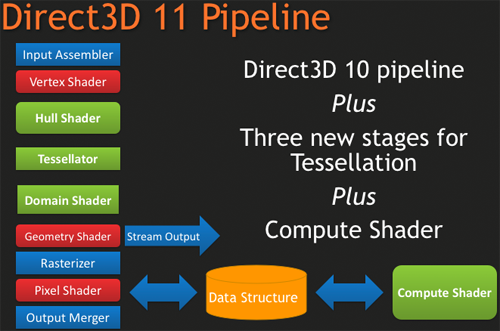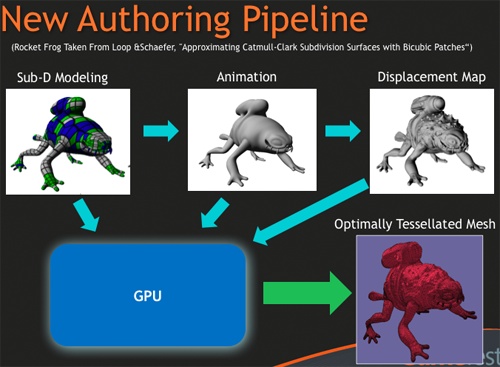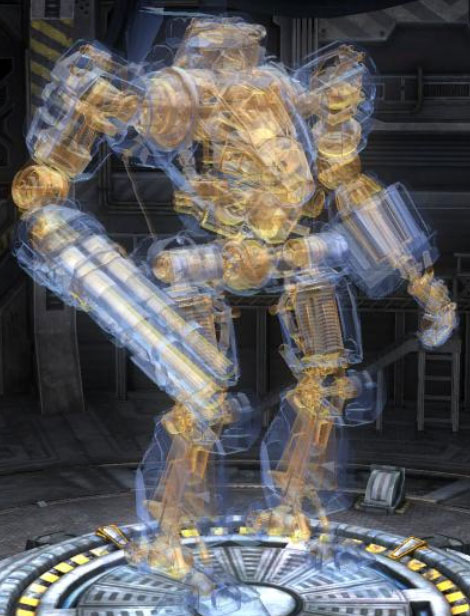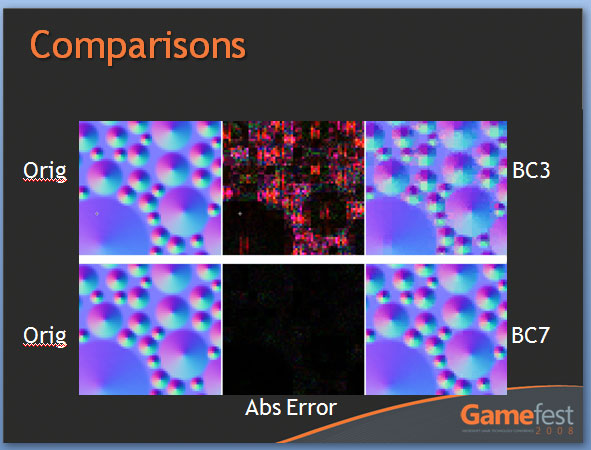AMD's Radeon HD 5870: Bringing About the Next Generation Of GPUs
by Ryan Smith on September 23, 2009 9:00 AM EST- Posted in
- GPUs
DirectX11 Redux
With the launch of the 5800 series, AMD is quite proud of the position they’re in. They have a DX11 card launching a month before DX11 is dropped on to consumers in the form of Win7, and the slower timing of NVIDIA means that AMD has had silicon ready far sooner. This puts AMD in the position of Cypress being the de facto hardware implementation of DX11, a situation that is helpful for the company in the long term as game development will need to begin on solely their hardware (and programmed against AMD’s advantages and quirks) until such a time that NVIDIA’s hardware is ready. This is not a position that AMD has enjoyed since 2002 with the Radeon 9700 and DirectX 9.0, as DirectX 10 was anchored by NVIDIA due in large part to AMD’s late hardware.
As we have already covered DirectX 11 in-depth with our first look at the standard nearly a year ago, this is going to be a recap of what DX11 is bringing to the table. If you’d like to get the entire inside story, please see our in-depth DirectX 11 article.
DirectX 11, as we have previously mentioned, is a pure superset of DirectX 10. Rather than being the massive overhaul of DirectX that DX10 was compared to DX9, DX11 builds off of DX10 without throwing away the old ways. The result of this is easy to see in the hardware of the 5870, where as features were added to the Direct3D pipeline, they were added to the RV770 pipeline in its transformation into Cypress.

New to the Direct3D pipeline for DirectX 11 is the tessellation system, which is divided up into 3 parts, and the Computer Shader. Starting at the very top of the tessellation stack, we have the Hull Shader. The Hull Shader is responsible for taking in patches and control points (tessellation directions), to prepare a piece of geometry to be tessellated.
Next up is the tesselator proper, which is a rather significant piece of fixed function hardware. The tesselator’s sole job is to take geometry and to break it up into more complex portions, in effect creating additional geometric detail from where there was none. As setting up geometry at the start of the graphics pipeline is comparatively expensive, this is a very cool hack to get more geometric detail out of an object without the need to fully deal with what amounts to “eye candy” polygons.
As the tesselator is not programmable, it simply tessellates whatever it is fed. This is what makes the Hull Shader so important, as it’s serves as the programmable input side of the tesselator.
Once the tesselator is done, it hands its work off to the Domain Shader, along with the Hull Shader handing off its original inputs to the Domain Shader too. The Domain Shader is responsible for any further manipulations of the tessellated data that need to be made such as applying displacement maps, before passing it along to other parts of the GPU.

The tesselator is very much AMD’s baby in DX11. They’ve been playing with tesselators as early as 2001, only for them to never gain traction on the PC. The tesselator has seen use in the Xbox 360 where the AMD-designed Xenos GPU has one (albeit much simpler than DX11’s), but when that same tesselator was brought over and put in the R600 and successive hardware, it was never used since it was not a part of the DirectX standard. Now that tessellation is finally part of that standard, we should expect to see it picked up and used by a large number of developers. For AMD, it’s vindication for all the work they’ve put into tessellation over the years.
The other big addition to the Direct3D pipeline is the Compute Shader, which allows for programs to access the hardware of a GPU and treat it like a regular data processor rather than a graphical rendering processor. The Compute Shader is open for use by games and non-games alike, although when it’s used outside of the Direct3D pipeline it’s usually referred to as DirectCompute rather than the Compute Shader.
For its use in games, the big thing AMD is pushing right now is Order Independent Transparency, which uses the Compute Shader to sort transparent textures in a single pass so that they are rendered in the correct order. This isn’t something that was previously impossible using other methods (e.g. pixel shaders), but using the Compute Shader is much faster.

Other features finding their way into Direct3D include some significant changes for textures, in the name of improving image quality. Texture sizes are being bumped up to 16K x 16K (that’s a 256MP texture) which for all practical purposes means that textures can be of an unlimited size given that you’ll run out of video memory before being able to utilize such a large texture.
The other change to textures is the addition of two new texture compression schemes, BC6H and BC7. These new texture compression schemes are another one of AMD’s pet projects, as they are the ones to develop them and push for their inclusion in DX11. BC6H is the first texture compression method dedicated for use in compressing HDR textures, which previously compressed very poorly using even less-lossy schemes like BC3/DXT5. It can compress textures at a lossy 6:1 ratio. Meanwhile BC7 is for use with regular textures, and is billed as a replacement for BC3/DXT5. It has the same 3:1 compression ratio for RGB textures.
We’re actually rather excited about these new texture compression schemes, as better ways to compress textures directly leads to better texture quality. Compressing HDR textures allows for larger/better textures due to the space saved, and using BC7 in place of BC3 is an outright quality improvement in the same amount of space, given an appropriate texture. Better compression and tessellation stand to be the biggest benefactors towards improving the base image quality of games by leading to better textures and better geometry.
We had been hoping to supply some examples of these new texture compression methods in action with real textures, but we have not been able to secure the necessary samples in time. In the meantime we have Microsoft’s examples from GameFest 2008, which drive the point home well enough in spite of being synthetic.

Moving beyond the Direct3D pipeline, the next big feature coming in DirectX 11 is better support for multithreading. By allowing multiple threads to simultaneously create resources, manage states, and issue draw commands, it will no longer be necessary to have a single thread do all of this heavy lifting. As this is an optimization focused on better utilizing the CPU, it stands that graphics performance in GPU-limited situations stands to gain little. Rather this is going to help the CPU in CPU-limited situations better utilize the graphics hardware. Technically this feature does not require DX11 hardware support (it’s a high-level construct available for use with DX10/10.1 cards too) but it’s still a significant technology being introduced with DX11.
Last but not least, DX11 is bringing with it High Level Shader Language 5.0, which in turn is bringing several new instructions that are primarily focused on speeding up common tasks, and some new features that make it more C-like. Classes and interfaces will make an appearance here, which will make shader code development easier by allowing for easier segmentation of code. This will go hand-in-hand with dynamic shader linkage, which helps to clean up code by only linking in shader code suitable for the target device, taking the management of that task out of the hands of the coder.










327 Comments
View All Comments
Wreckage - Wednesday, September 23, 2009 - link
Hot, loud, huge power draw and it barely beats a 285.A disappointment for sure.
SiliconDoc - Thursday, September 24, 2009 - link
Thank you Wreckage, now, I was going to say draw up your shields, but it's too late, the attackers have already had at it.--
Thanks for saying what everyone was thinking. You are now "a hated fanboy", "a paid shill" for the "corporate greedy monster rip off machine", according to the real fanboy club, the ones who can't tell the truth, no matter what, and prefer their fantasiacal spins and lies.
Zstream - Wednesday, September 23, 2009 - link
They still allow you to post?yacoub - Wednesday, September 23, 2009 - link
He's right in the first sentence but went all fanboy in the second.Griswold - Wednesday, September 23, 2009 - link
Not really, he's a throughbred fanboy with everything he said. Even on the "loud" claim compared to what previous reference designs vom ATI were like...SiliconDoc - Wednesday, September 30, 2009 - link
So if YOU compare one loud design of ati's fan to another fan and as loud ati card( they're all quieter than 5870* but we'll make believe for you for now),
and they're both loud, anyone complaining about one of them being loud is "an nvidia fanboy" because he isn't aware of the other loud as heck ati cards, which of course, make another loud one "just great" and "not loud". LOL
It's just amazing, and if it was NV:
" This bleepity bleep fan and card are like a leaf blower again, just like the last brute force monster core power hog but this **tard is a hurricane with no eye."
But since it's the red cards that are loud, as YOU pointed out in the plural, not singular like the commenter, according to you HE's the FANBOY, because he doesn't like it. lol
ULTIMATE CONCLUSION: The commenter just told the truth, he was hoping for more, but was disappointed. YOU, the raging red, jumped his case, and pointed out the ati cards are loud "vom" prior.. and so he has no right to be a big green whining fanboy...
ROFLMAO
I bet he's a "racist against reds" every time he validly criticizes their cards, too.
---
the 5870 is THE LOUDEST ATI CARD ON THE CHART,AND THE LOUDEST SINGLE CORE CARD.
--
Next, the clucking rooster will whiplash around and flap the stubby wings at me, claiming at idle it only draws 27 watts and is therefore quiet.
As usual, the sane would them mention it will be nice not playing any 3d games with a 3d gaming card, and enjoying the whispery hush.
--
In any case:
Congratulations, you've just won the simpleton's red rooster raving rager thread contest medal and sarcastic unity award.(It's as real as any points you've made)
Anyhow thanks, you made me notice THE 5870 IS THE LOUDEST CARD ON THE CHARTS. I was too busy pointing out the dozen plus other major fibboes to notice.
It's the loudest ati card, ever.
GourdFreeMan - Wednesday, September 23, 2009 - link
I thought the technical portion of your review was well written. It is clear, concise and written to the level of understanding of your target audience. However, I am less than impressed with your choice of benchmarks. Why is everything run at 4xAA, 16xAF? Speaking for most PC gamers, I would have maxed the settings in Crysis Warhead before adding AA and AF. Also, why so many console ports? Neither I, nor anyone else I personally know have much interest in console ports (excluding RPGs from Bethesda). Where is Stalker: Clear Sky? As you note its sequel will be out soon. Given the short amount of time they had to work with DX11, I imagine it will run similarly to Stalker: Call of Pripyat. Also, where is ArmA II? Other than Crysis and Stalker it is the game most likely to be constrained by the GPU.I don't want to sound conspiratorial, but your choice of games and AA/AF settings closely mirror AMD's leaked marketing material. It is good that you put their claims to the test, as I trust Anandtech as an unbiased review site, but I don't think the games you covered properly cover the interests of PC gamers.
Ryan Smith - Wednesday, September 23, 2009 - link
For the settings we use, we generally try to use the highest settings possible. That's why everything except Crysis is at max quality and 4xAA 16xAF (bear in mind that AF is practically free these days). Crysis is the exception because of its terrible performance; Enthusiast level shaders aren't too expensive and improve the quality more than anything else, without driving performance right off a cliff. As far as playing the game goes, we would rather have AA than the rest of the Enthusiast features.As for our choice of games, I will note that due to IDF and chasing down these crazy AA bugs, we didn't get to run everything we wanted to. GRID and Wolfenstein (our OpenGL title) didn't make the cut. As for Stalker, we've had issues in the past getting repeatable results, so it's not a very reliable benchmark. It also takes quite a bit of time to run, and I would have had to drop (at least) 2 games to run it.
Overall our game selection is based upon several factors. We want to use good games, we want to use popular games so that the results are relevant for the most people, we want to use games that give reliable results, and ideally we want to use games that we can benchmark in a reasonable period of time (which means usually having playback/benchmark tools). We can't cover every last game, so we try to get what we can using the criteria above.
GourdFreeMan - Thursday, September 24, 2009 - link
Popularity and quality are strong arguments for World of Warcraft, Left 4 Dead, Crysis, Far Cry, the newly released Batman game... and *maybe* Resident Evil (though it is has far greater popularity among console gamers). However, HAWX? Battleforge? I would never have even heard of these games had I not looked them up on Wikipedia. In retrospect I can see you using Battleforge due to it being the only DirectX 11 title, but I still don't find your list of games compelling or comprehensive.To me *PC* gaming needs to offer something more than simple action to justify its cost of entry. In the past this included open worlds, multiplayer, greater graphical realism and attempts at balancing realistic simulation with entertaining game play. Console gaming has since offered the first two, but the latter are still lacking.
It's games like Crysis, Stalker and ArmA II along with the potential of modding that attract people to PC gaming in the first place...
dvijaydev46 - Wednesday, September 23, 2009 - link
Good review but it would be good if you could also add Steam and Cuda benchmarks. Now you have a common software Mediashow Espresso right?